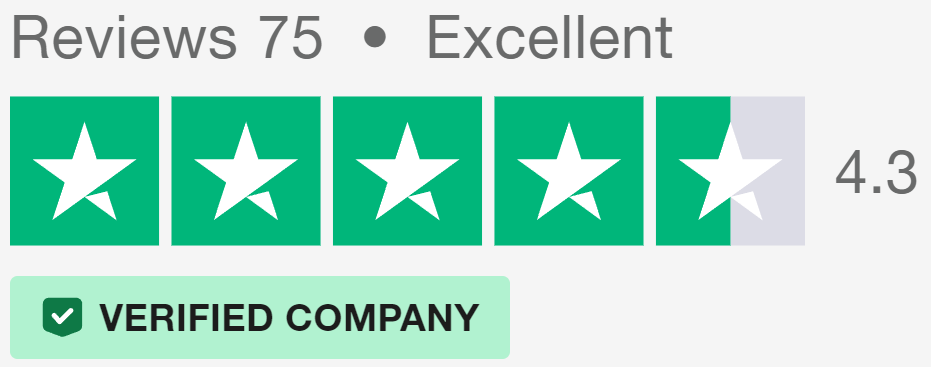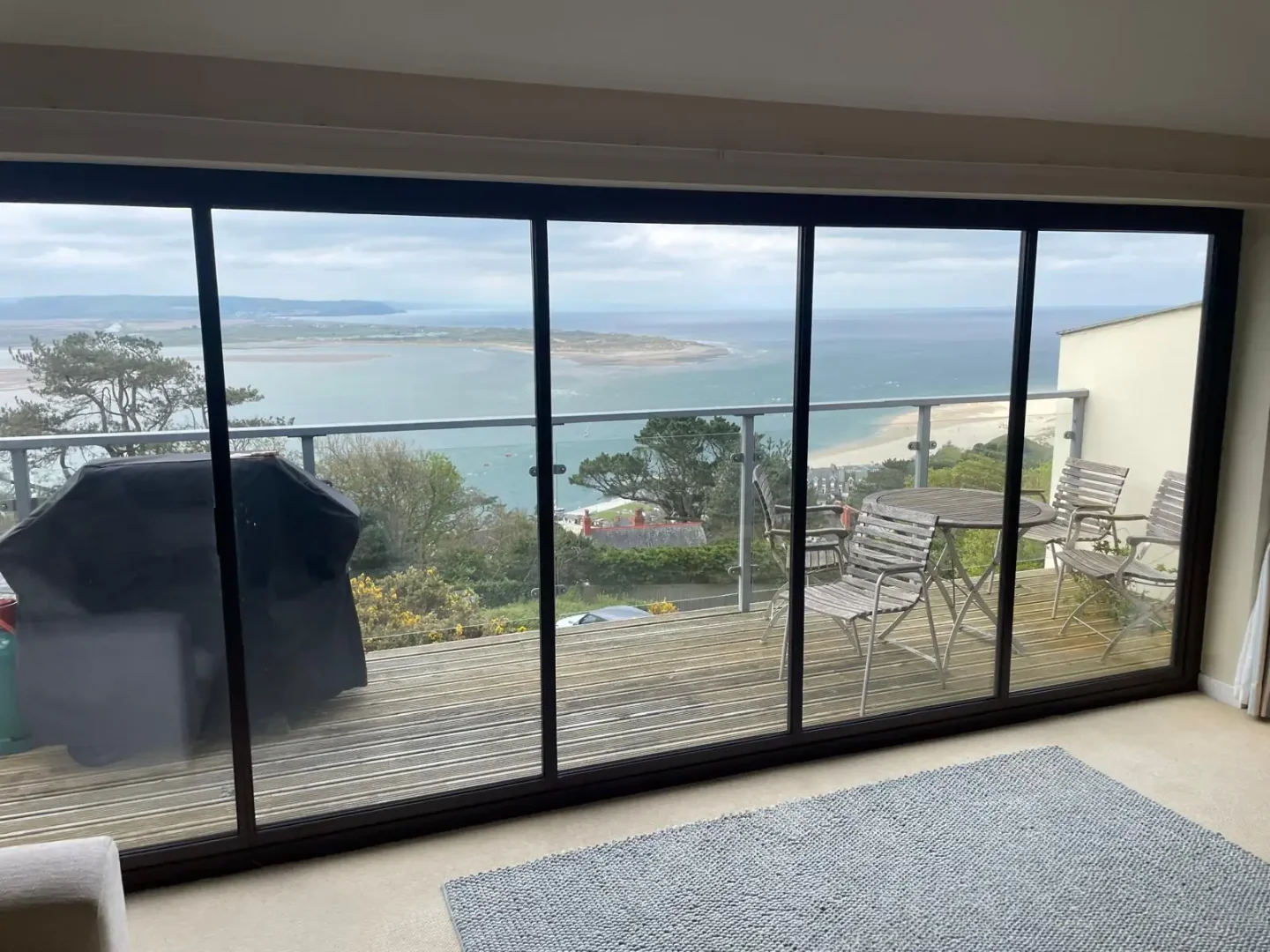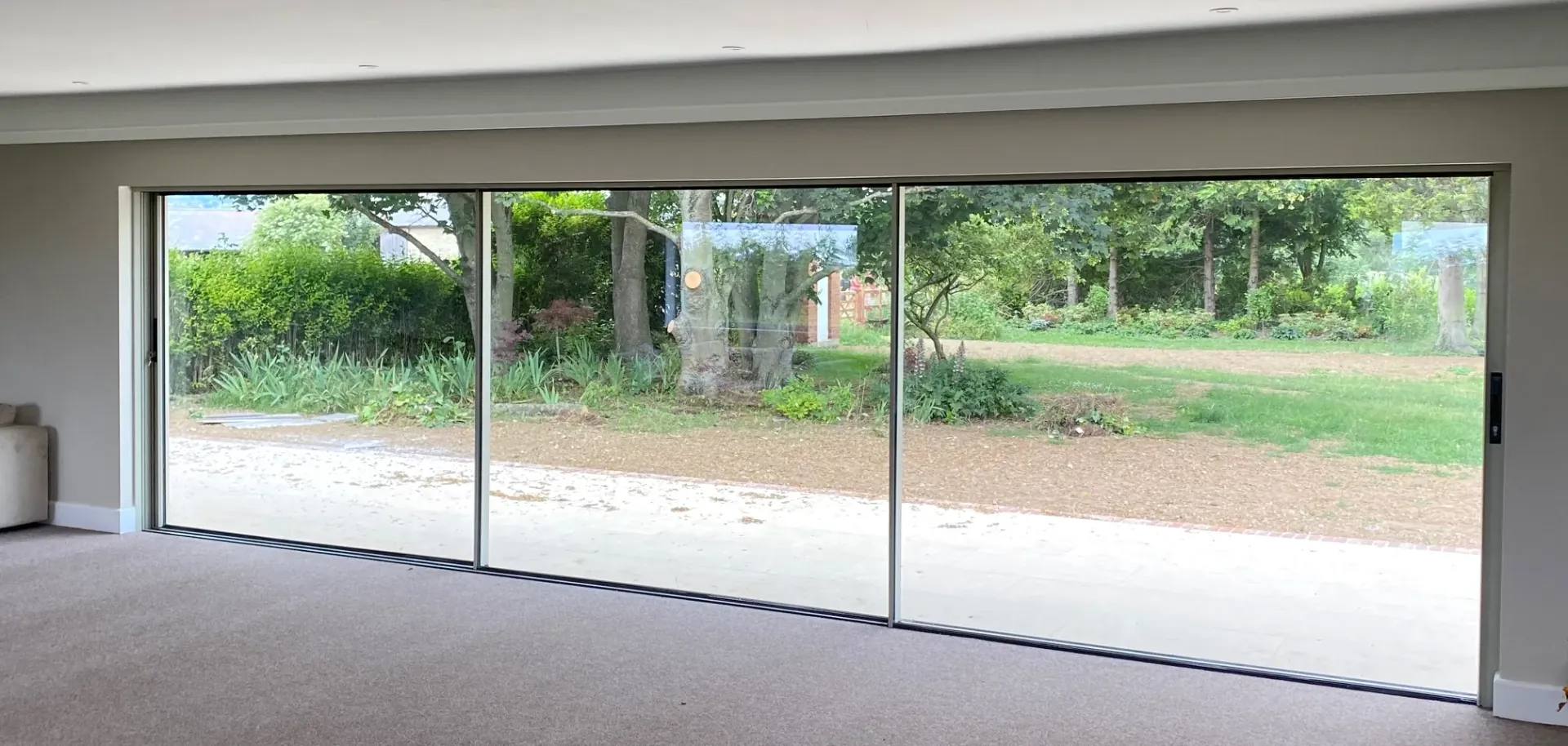Wide Sliding Doors: Sizes, Systems and Styles
Table of Contents

What Are Wide Sliding Doors?
Modern homes often feature wide sliding doors that stretch across entire walls, bringing natural light deep into living spaces. These large-scale glazed panels differ substantially from standard patio doors in both their dimensions and technical specifications.

Standard vs Wide Measurements
Wide sliding doors start where standard patio doors reach their limits. While typical sliding doors span up to 2 or 3 metres, wide patio doors can stretch to more than twice or three times that size.
The outer frame needs careful reinforcement to support these broader spans, with aluminium proving particularly suitable for maintaining stability across wider openings.
Extra wide patio doors require thicker glass and more robust hardware to operate smoothly. The relationship between panel height and width becomes especially important – taller doors might need narrower panels to maintain structural integrity.
Maximum Width Limits
Structural limitations vary based on door material and site conditions. Aluminium slide doors can span greater widths than uPVC or timber frames thanks to their superior strength-to-weight ratio. Building regulations and local wind loads also affect the maximum size of exterior doors. Wide sliding doors may need substantial steel reinforcement above the opening, while the track system must be precisely engineered to handle heavier panels. Track designs often incorporate additional rollers and stronger materials to ensure reliable operation despite the increased weight and momentum of wider panels.
Panel Configuration Options
Multi-panel systems offer various arrangements for wide openings. Double-track designs allow two panels to slide behind one another, while triple-track systems enable three panels to stack. The number of panels affects both the practical operation and visual impact of wide sliding doors in your space.
Glass specification changes with panel size too. Larger panes require toughened or laminated safety glass of increased thickness. This affects not just safety but also the door’s thermal performance and sound insulation properties. Proper glazing selection helps maintain uninterrupted views while meeting building standards for larger openings.
Types of Wide Sliding Doors for Large Spaces
Glass patio doors come in several distinct systems, each suited to different opening widths and configurations. The right choice depends on factors like available wall space, desired opening width, and how you plan to use the space.
Double Track Systems
Floor to ceiling sliding doors on double tracks offer impressive width potential while keeping the mechanism straightforward. Two parallel tracks allow panels to glide independently, with one sliding behind the other when opened. The fixed panel typically sits on the outer track, while the sliding panel moves along the inner track.
Heavy-duty aluminium frames support the substantial glass weight in these wider systems. Double track wide sliding doors work particularly well for openings between 3 and 4 metres, though larger sizes are possible with appropriate structural support.
Well-engineered running gear proves essential as panel sizes grow. Precision-machined rollers, often made from hardened steel or specialist polymers, carry loads upwards of 200kg per panel. These components need regular maintenance to maintain smooth operation, especially in coastal areas where salt air can affect metal parts.
Triple Track Sliding Doors
When standard double tracks can’t provide enough width, triple track systems offer a solution. These wide sliding doors accommodate three parallel panels, each running on its own track. This setup allows for broader openings without compromising on glass panel stability.
Panel configurations in triple track systems provide more flexibility. You might choose to have two sliding panels and one fixed, or all three panels mobile. The trade-off comes in frame depth – triple tracks need deeper frames to house the additional running gear.
The stacking arrangement affects both practicality and aesthetics. Panels can stack to one side or split to both sides of the opening. Some systems allow all panels to slide together, creating a complete opening, while others require at least one fixed panel.

Slide and Turn Doors
Unlike conventional wide patio doors that slide straight back, slide and turn systems combine sliding and pivoting movements. Each panel first slides along the track, then pivots 90 degrees to stack perpendicularly against the wall. This design allows for complete opening of the doorway without any fixed panels blocking the view.
Structural requirements differ from standard sliding systems. The track must support not just the sliding motion but also the turning movement, requiring additional fixings and stronger materials. The pivot action also means these systems need more clearance space when open.
The weather performance of slide and turn doors matches that of traditional sliding systems. Multiple brush seals and interlocking sections keep out draughts and rain, while thermal breaks in the frames help maintain energy efficiency. The numerous contact points between panels actually provide improved sound insulation compared to simpler sliding designs.
Training occupants on proper operation helps prevent issues. The specific opening sequence matters – panels must be moved in the correct order and fully engaged in their turning positions. However, once mastered, these doors provide unmatched flexibility in how you use your space.
Glass and Frame Options for Larger Doors
Wide sliding doors require careful material selection to ensure durability and smooth operation. Unlike narrow sliding doors, which often work well with basic uPVC frames, larger systems need more robust construction.
Glass Requirements
Large panes of glass create specific engineering challenges in wide sliding doors. The glass thickness must increase proportionally with panel size to maintain structural integrity. Double-glazed units in these systems typically range from 28mm to 36mm thick, combining two or more glass layers with gas-filled spaces between them.
Laminated glass proves essential for safety in larger panels. The internal PVB (polyvinyl butyral) layer holds fragments together if breakage occurs. This construction also improves acoustic performance – particularly valuable when installing wide patio doors in busy urban settings.
Solar control coatings help regulate temperature without compromising clarity. These microscopic metal layers reflect heat while allowing natural light through. The coating specification becomes especially important for south-facing external doors, where heat gain could otherwise make rooms uncomfortable.
Frame Materials for Wide Spans
Aluminium patio doors dominate the market for wider openings, thanks to their strength and slim profiles. The material’s high strength-to-weight ratio allows for narrower frames that support heavy glass panels while maintaining clean sightlines. Modern thermal break technology prevents heat transfer through aluminium doors, addressing the material’s natural conductivity.
While uPVC patio doors suit smaller openings well, they struggle with the structural demands of wider spans. The material requires thicker frames and more reinforcement, which can look bulky. However, uPVC’s lower price point makes it worth considering for moderate widths in sheltered locations.
Thermal Performance
Wide sliding doors need additional features to maintain thermal efficiency. Multiple thermal breaks in the frame create barriers against heat transfer, while warm-edge spacer bars between glass panes reduce condensation risk. The larger glass area actually helps capture solar gain in winter, though summer cooling needs careful planning.
The gap between glass panes makes a big difference to the amount of insulation provided by the doors. Argon or krypton gas filling improves thermal performance compared to air. Wider gaps between panes can boost insulation further, though this must be balanced against the increased overall unit thickness and weight.
Deeper profiles allow for better insulation and more substantial weather seals, particularly important in exposed locations. The thermal performance of these deeper sections helps offset the increased heat loss through larger glazed areas.
Quality gaskets and brush seals become even more important as door sizes increase. The longer perimeter of wide sliding doors creates more opportunities for drafts without proper sealing.
Track drainage needs careful design in wider systems. More width means more water collection potential, requiring additional drainage channels and paths to direct water away from the building. Some systems incorporate concealed drainage slots that prevent leaves and debris from blocking water escape routes.
Matching Wide Doors to Your Home’s Style
Modern patio doors need to work in harmony with your property’s architecture. Wide sliding doors suit various building types, from Victorian terraces to new-builds, when chosen with care.

Modern Homes
Contemporary properties often feature dark grey or black framed doors to create bold visual statements. The slim frames of aluminium patio doors work particularly well here, offering clean lines that match modern architectural elements.
Wide glazed panels in dark frames draw attention to views while adding structural rhythm to facades.
Raw materials play into different design approaches. Exposed concrete or steel elements pair naturally with industrial-style door frames, while rendered walls might call for softer frame finishes. The current trend for dark exterior frames stems partly from their ability to virtually disappear when looking through the glass.
Today’s systems offer a wide range of colours beyond standard white or grey. Powder-coated finishes provide durability while allowing precise colour matching to other building elements. Some homeowners opt for different colours inside and out, coordinating interior frames with room schemes while maintaining a consistent exterior appearance.
Period Properties
Victorian and Georgian buildings require thoughtful integration of wide sliding doors. The key lies in respecting original proportions while adding contemporary glazing. Traditional sash window dimensions often provide useful guides for panel sizes and frame positions.
Wide patio doors can actually highlight period features rather than compete with them. Setting door frames behind existing masonry helps maintain architectural character, while the glass itself reflects and emphasises original details. Original materials like London stock brick or Bath stone take on new life when contrasted with precise modern glazing.
Internal period features need equal attention when fitting sliding garden doors. Ornate cornices and dado rails might need careful adaptation around new frame positions. Some installations incorporate traditional architraves around modern frames, bridging old and new elements effectively.
Coastal Properties
Seafront homes face unique challenges with wide sliding doors. Salt-laden air demands superior finishing and maintenance regimes. Marine-grade powder coating provides essential protection for metal frames, while stainless steel hardware resists corrosion better than standard fittings.
Wind loads affect both frame specification and glass thickness in coastal settings. Extra structural support above wider openings helps counter increased wind pressure, while deeper frames provide better weather protection. Some coastal installations use additional seals or drainage channels to handle driven rain.
The orientation of wide sliding doors becomes especially important near the coast. North-facing installations might need triple glazing for warmth, while south-facing glass often benefits from solar control coating to prevent overheating. Local climate patterns influence both technical specifications and daily usability.
Managing Light and Heat in Large Glass Areas
Glass doors in broader spans need careful management of natural light and temperature. Wide sliding doors can affect room comfort throughout the year, making solar control important for comfortable living.
Solar Control
Direct sunlight through wide sliding patio doors affects both comfort and furniture. UV-protective glass coatings shield furnishings from fading while reducing heat gain. These invisible layers cut solar energy transfer by up to 80% without darkening the glass or blocking views.
Modern glazing units combine multiple technologies to regulate heat and light. Low-emissivity coatings bounce heat back into rooms during winter while reflecting unwanted solar gain in summer. The spacing between glass layers also impacts thermal performance – wider gaps generally improve insulation but increase overall unit weight.
Automated blinds offer practical control over larger glazed areas. Motors hidden within the door frame raise and lower blinds on schedule or in response to sun sensors. Some systems integrate with home automation, adjusting automatically to maintain comfortable temperatures while reducing energy bills.
Heat loss through wide sliding doors requires attention to detail. Double-glazed units filled with argon gas provide better insulation than traditional air-filled units. The thermal break in the frame proves equally important, preventing cold spots where condensation might form.
Privacy Options
Toughened safety glass with built-in privacy features provides an elegant solution for exposed areas. Various options include acid-etched patterns, ceramic frits, or switchable electric glass that turns opaque at the touch of a button. Each method maintains natural light while controlling visibility.
Smart glass technology suits modern homes particularly well. Though initially expensive, these systems eliminate the need for separate blinds or curtains. The glass switches from clear to opaque instantly, powered by a small electric current that realigns liquid crystals within the glazing unit.
Traditional privacy solutions still work effectively with wide patio doors. External louvres or screens can shade glass while adding architectural interest. Some homeowners opt for garden planting to create natural screening that changes with the seasons.

Light Control Methods
Managing glare becomes essential with larger glass areas. Internal blinds between the glass panes offer one solution, protected from dust while providing adjustable shade. These systems need careful maintenance as any mechanical failure requires complete glass unit replacement.
Reflective glass helps control brightness without compromising security. Unlike traditional tinted glass, modern reflective coatings work differently day and night. During daylight, they limit view into the property while maintaining clear outward vision for occupants.
The position of artificial lighting needs careful planning around wide sliding doors. Poorly placed lights create reflections that obscure views after dark. Lighting specialists often recommend indirect illumination to reduce glare on glass surfaces while maintaining evening views.
Patio door security features integrate with privacy needs. Multi-point locking systems work alongside laminated glass to resist break-ins without compromising light transmission. Some systems include integral alarm contacts, alerting security systems if panels move unexpectedly.
Regular cleaning affects both light transmission and thermal performance. Larger glass areas show dirt more readily than smaller windows, requiring more frequent maintenance. Some manufacturers offer self-cleaning glass coatings that use sunlight and rain to break down dirt, reducing maintenance needs.
Designing Around Wide Sliding Doors
Room layouts need careful planning when glass becomes a major feature. Wide sliding doors affect everything from furniture placement to lighting schemes, changing how spaces work throughout the day.
Kitchen and Living Spaces
Open-plan areas benefit from made to measure sliding doors that match the room’s proportions. The position of kitchen islands and dining tables relative to glass panels affects both practicality and visual impact. Placing heavy furniture away from door tracks ensures smooth daily operation while maintaining clear paths.
Cooking areas need specific attention when positioned near extra wide sliding doors. Steam and cooking odours require good ventilation, often through ceiling-mounted extractors rather than wall units that might interrupt glass panels. Some kitchens incorporate ventilation slots in floors or ceilings to manage air flow without blocking views.
Natural light changes how paint colours appear throughout the day. Strong sunlight through glass doors an wash out subtle shades, while evening light might create unwanted reflections. Testing paint samples at different times helps predict how colours will work in changing conditions.
Indoor Pool Areas
Swimming pools adjacent to wide sliding doors need specialised environmental controls. Humidity levels affect both glass and frame materials, requiring additional ventilation to prevent condensation. Some installations include automated systems that adjust air flow based on temperature and moisture readings.
Glass doors in pool areas face unique safety requirements. Non-slip flooring must extend the full width of door openings, while drainage channels prevent water pooling near tracks. Frame materials need superior corrosion resistance to handle chlorinated air, often demanding marine-grade finishes.
Pool heating costs relate directly to glazing specification. Triple glazing might prove cost-effective despite higher initial expense, particularly in year-round pools where heat loss affects running costs. Solar control glass helps manage temperatures during summer without losing valuable heat in winter.
Patio Integration
Exterior surfaces around glass doors need careful selection. Paving materials should sit slightly lower than interior floors, allowing for drainage while maintaining smooth passage. Some installations use concealed channels to collect rainwater before it reaches internal spaces.
Planting schemes can soften the visual impact of wide patio doors. Low-growing species near glass panels avoid blocking light while providing seasonal interest. Careful species selection prevents root systems from interfering with door tracks or drainage.
Material Transitions
Floor finishes that work both inside and out create visual continuity. Porcelain tiles prove popular, offering slip resistance and durability while maintaining a consistent look. The substrate preparation becomes particularly important with wider openings, as any movement could affect door operation.
Textiles and soft furnishings affect room acoustics differently when walls become glass. Sound reflections from glass doors can create echo effects in larger spaces. Strategic placement of rugs, curtains, or acoustic panels helps manage sound without compromising the benefits of wide glazed areas.
Furniture arrangement affects traffic patterns around wide sliding doors. Seating oriented towards views works well, but needs enough space for comfortable passage when doors operate. Some homeowners opt for modular furniture that adapts easily as needs change through seasons.
We’d Love to Help You
Vision Glass Doors is a designer, manufacturer, and installer of premium door systems. We are a family run business with over 20 years’ experience and 5,000 installations across the UK.
Our leading range of door systems include Ultra Slim – Slide and Turn Doors, Slimline Sliding Patio Doors and Frameless Glass Doors. Suitable for various internal and external applications, they are applicable to residential and commercial projects.
Click Quick Quote Online for a free quotation within 24 hours. Alternatively, call or email us on 01582 492730 or at info@visionglassdoors.co.uk.

